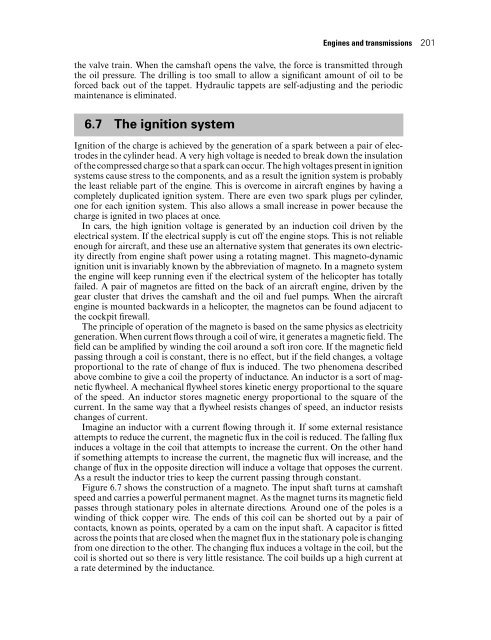The Art of the Helicopter John Watkinson - Karatunov.net
The Art of the Helicopter John Watkinson - Karatunov.net
The Art of the Helicopter John Watkinson - Karatunov.net
Create successful ePaper yourself
Turn your PDF publications into a flip-book with our unique Google optimized e-Paper software.
Engines and transmissions 201<br />
<strong>the</strong> valve train. When <strong>the</strong> camshaft opens <strong>the</strong> valve, <strong>the</strong> force is transmitted through<br />
<strong>the</strong> oil pressure. <strong>The</strong> drilling is too small to allow a significant amount <strong>of</strong> oil to be<br />
forced back out <strong>of</strong> <strong>the</strong> tappet. Hydraulic tappets are self-adjusting and <strong>the</strong> periodic<br />
maintenance is eliminated.<br />
6.7 <strong>The</strong> ignition system<br />
Ignition <strong>of</strong> <strong>the</strong> charge is achieved by <strong>the</strong> generation <strong>of</strong> a spark between a pair <strong>of</strong> electrodes<br />
in <strong>the</strong> cylinder head. A very high voltage is needed to break down <strong>the</strong> insulation<br />
<strong>of</strong> <strong>the</strong> compressed charge so that a spark can occur. <strong>The</strong> high voltages present in ignition<br />
systems cause stress to <strong>the</strong> components, and as a result <strong>the</strong> ignition system is probably<br />
<strong>the</strong> least reliable part <strong>of</strong> <strong>the</strong> engine. This is overcome in aircraft engines by having a<br />
completely duplicated ignition system. <strong>The</strong>re are even two spark plugs per cylinder,<br />
one for each ignition system. This also allows a small increase in power because <strong>the</strong><br />
charge is ignited in two places at once.<br />
In cars, <strong>the</strong> high ignition voltage is generated by an induction coil driven by <strong>the</strong><br />
electrical system. If <strong>the</strong> electrical supply is cut <strong>of</strong>f <strong>the</strong> engine stops. This is not reliable<br />
enough for aircraft, and <strong>the</strong>se use an alternative system that generates its own electricity<br />
directly from engine shaft power using a rotating mag<strong>net</strong>. This mag<strong>net</strong>o-dynamic<br />
ignition unit is invariably known by <strong>the</strong> abbreviation <strong>of</strong> mag<strong>net</strong>o. In a mag<strong>net</strong>o system<br />
<strong>the</strong> engine will keep running even if <strong>the</strong> electrical system <strong>of</strong> <strong>the</strong> helicopter has totally<br />
failed. A pair <strong>of</strong> mag<strong>net</strong>os are fitted on <strong>the</strong> back <strong>of</strong> an aircraft engine, driven by <strong>the</strong><br />
gear cluster that drives <strong>the</strong> camshaft and <strong>the</strong> oil and fuel pumps. When <strong>the</strong> aircraft<br />
engine is mounted backwards in a helicopter, <strong>the</strong> mag<strong>net</strong>os can be found adjacent to<br />
<strong>the</strong> cockpit firewall.<br />
<strong>The</strong> principle <strong>of</strong> operation <strong>of</strong> <strong>the</strong> mag<strong>net</strong>o is based on <strong>the</strong> same physics as electricity<br />
generation. When current flows through a coil <strong>of</strong> wire, it generates a mag<strong>net</strong>ic field. <strong>The</strong><br />
field can be amplified by winding <strong>the</strong> coil around a s<strong>of</strong>t iron core. If <strong>the</strong> mag<strong>net</strong>ic field<br />
passing through a coil is constant, <strong>the</strong>re is no effect, but if <strong>the</strong> field changes, a voltage<br />
proportional to <strong>the</strong> rate <strong>of</strong> change <strong>of</strong> flux is induced. <strong>The</strong> two phenomena described<br />
above combine to give a coil <strong>the</strong> property <strong>of</strong> inductance. An inductor is a sort <strong>of</strong> mag<strong>net</strong>ic<br />
flywheel. A mechanical flywheel stores ki<strong>net</strong>ic energy proportional to <strong>the</strong> square<br />
<strong>of</strong> <strong>the</strong> speed. An inductor stores mag<strong>net</strong>ic energy proportional to <strong>the</strong> square <strong>of</strong> <strong>the</strong><br />
current. In <strong>the</strong> same way that a flywheel resists changes <strong>of</strong> speed, an inductor resists<br />
changes <strong>of</strong> current.<br />
Imagine an inductor with a current flowing through it. If some external resistance<br />
attempts to reduce <strong>the</strong> current, <strong>the</strong> mag<strong>net</strong>ic flux in <strong>the</strong> coil is reduced. <strong>The</strong> falling flux<br />
induces a voltage in <strong>the</strong> coil that attempts to increase <strong>the</strong> current. On <strong>the</strong> o<strong>the</strong>r hand<br />
if something attempts to increase <strong>the</strong> current, <strong>the</strong> mag<strong>net</strong>ic flux will increase, and <strong>the</strong><br />
change <strong>of</strong> flux in <strong>the</strong> opposite direction will induce a voltage that opposes <strong>the</strong> current.<br />
As a result <strong>the</strong> inductor tries to keep <strong>the</strong> current passing through constant.<br />
Figure 6.7 shows <strong>the</strong> construction <strong>of</strong> a mag<strong>net</strong>o. <strong>The</strong> input shaft turns at camshaft<br />
speed and carries a powerful permanent mag<strong>net</strong>. As <strong>the</strong> mag<strong>net</strong> turns its mag<strong>net</strong>ic field<br />
passes through stationary poles in alternate directions. Around one <strong>of</strong> <strong>the</strong> poles is a<br />
winding <strong>of</strong> thick copper wire. <strong>The</strong> ends <strong>of</strong> this coil can be shorted out by a pair <strong>of</strong><br />
contacts, known as points, operated by a cam on <strong>the</strong> input shaft. A capacitor is fitted<br />
across <strong>the</strong> points that are closed when <strong>the</strong> mag<strong>net</strong> flux in <strong>the</strong> stationary pole is changing<br />
from one direction to <strong>the</strong> o<strong>the</strong>r. <strong>The</strong> changing flux induces a voltage in <strong>the</strong> coil, but <strong>the</strong><br />
coil is shorted out so <strong>the</strong>re is very little resistance. <strong>The</strong> coil builds up a high current at<br />
a rate determined by <strong>the</strong> inductance.










